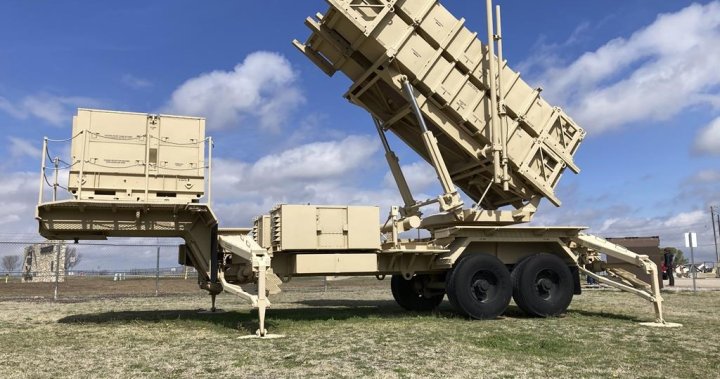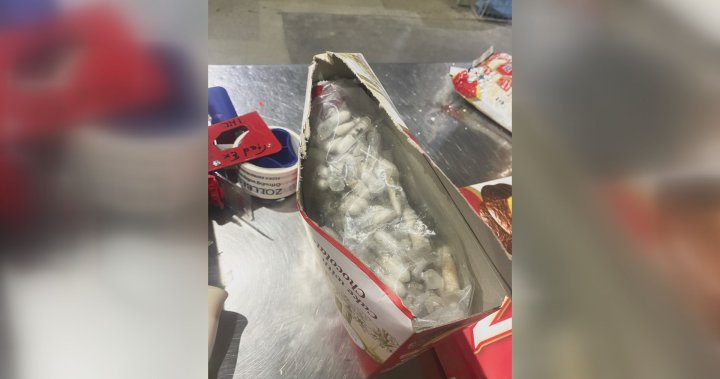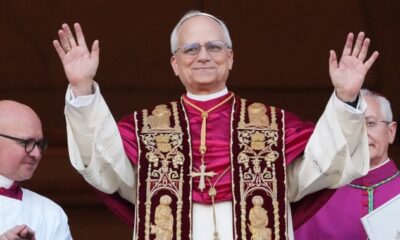Politics
Trump, Netanyahu set to meet as Israel and Hamas discuss ceasefire – National TenX News

Israeli Prime Minister Benjamin Netanyahu and U.S. President Donald Trump might look to take a victory lap on Monday after their recent joint strikes on Iran, hailed by both as an unmitigated success.
But as they meet for the third time this year, the outwardly triumphant visit will be dogged by Israel’s 21-month conflict against Hamas in Gaza and questions over how hard Trump will push for an end to the conflict.
Trump has made clear that following the 12-day conflict between Israel and Iran, he would like to see the Gaza conflict end soon. The meeting between Trump and Netanyahu could give new urgency to a U.S. ceasefire proposal being discussed by Israel and Hamas, but whether it leads to a deal that ends the conflict is unclear.
“The optics will be very positive,” said Michael Oren, a former Israeli ambassador to Washington. “But behind the victory lap are going to be some very serious questions.”
Before departing for Washington on Sunday, Netanyahu praised the cooperation with the U.S. for bringing a “huge victory over our shared enemy.” He struck a positive note on a ceasefire for Gaza, saying he was working “to achieve the deal under discussion, on the terms we agreed to.”
“I think that the discussion with President Trump can certainly help advance that result, which all of us hope for,” Netanyahu said.
‘It changes from day to day’
Israel and Hamas appear to be inching toward a new ceasefire agreement that would bring about a 60-day pause in the fighting, send aid flooding into Gaza and free at least some of the remaining 50 hostages held in the territory.
But a perennial sticking point is whether the ceasefire will end the conflict altogether. Hamas has said it is willing to free all the hostages in exchange for an end to the conflict and a full Israeli withdrawal from Gaza. Netanyahu says the conflict will end once Hamas surrenders, disarms and goes into exile — something it refuses to do.
Trump has made it clear that he wants to be known as a peacemaker. He has repeatedly trumpeted recent peace deals that his administration facilitated between India and Pakistan, the Democratic Republic of Congo and Rwanda, and Israel and Iran, and for years has made little secret of the fact that he covets a Nobel Peace Prize.

He has been pressuring Israel and Hamas to wrap up their own conflict, which has killed tens of thousands of Palestinians, ravaged Gaza, deepened Israel’s international isolation and made any resolution to the broader conflict between Israel and the Palestinians more distant than ever.

Get daily National news
Get the day’s top news, political, economic, and current affairs headlines, delivered to your inbox once a day.
But the precise details of the deal, and whether it can lead to an end to the conflict, are still in flux. In the days before Netanyahu’s visit, Trump seemed to downplay the chances for a breakthrough.
Asked on Friday how confident he was a ceasefire deal would come together, Trump told reporters: “I’m very optimistic — but you know, look, it changes from day to day.”
On Sunday evening, he seemed to narrow his expectation, telling reporters that he thought an agreement related to the remaining hostages would be reached in the coming week.
Trump and Netanyahu are more in sync than ever
Those mood swings also have embodied Trump’s relationship with Netanyahu.
After Trump’s decision to get involved in Israel’s war in Iran with strikes on Iranian nuclear sites, the two leaders are more in sync than ever. But that’s not always been the case.
As recently as Netanyahu’s last visit to Washington in April, the tone was markedly different.
Trump used the photo-op with Netanyahu to announce that the U.S. was entering into negotiations with Iran over its nuclear deal — appearing to catch the Israeli leader off guard and at the time, slamming the brakes on any Israeli military plan.
He also praised Turkish leader Recep Tayyip Erdogan, a fierce critic of Israel’s, in front of Netanyahu, and the two made no apparent progress on a trade deal at the height of Trump’s tariff expansion.

Trump, whose policies have largely aligned with Israel’s own priorities, pledged last week to be “very firm” with Netanyahu on ending the conflict, without saying what that would entail. Pressure by Trump has worked on Netanyahu in the past, with a ceasefire deal having been reached right as the president was taking office again.
Netanyahu has to balance the demands of his American ally with the far-right parties in his governing coalition who hold the key to his political survival and oppose ending the conflict.
But given the strong U.S. support in Israel’s war against Iran, highlighted by joint airstrikes on a fortified underground Iranian nuclear site, Netanyahu may have a tough time saying no.
On Sunday evening, Trump said one of the matters he expected to discuss with Netanyahu “is probably a permanent deal with Iran.”
Trump also may expect something in return for his recent calls for Netanyahu’s corruption trial to be canceled — a significant interference in the domestic affairs of a sovereign state.
“Trump thinks that Netanyahu owes him,” said Eytan Gilboa, an expert on U.S.-Israel affairs at Bar-Ilan University near Tel Aviv. “And if Trump thinks that he needs to end the conflict In Gaza, then that is what he will need to do.”
The two men will likely discuss the ceasefire with Iran and how to respond to any perceived violations.
But beyond Iran is Trump’s grand vision for a new Middle East, where he hopes that additional countries will join the Abraham Accords, a series of agreements normalizing relations between Arab countries and Israel brokered during Trump’s first term.
Netanyahu and Trump are likely to discuss how to bring Syria into the fold. The country, a longtime enemy of Israel’s, has new leadership after the fall of President Bashar Assad, and experts say conditions might be ripe for some kind of nonbelligerency agreement.
But Trump’s ultimate goal is to include regional powerhouse Saudi Arabia.
The Saudis, whose clout could open the door for other Arab or Muslim countries to join, have expressed interest in normalizing ties with Israel but only if it is accompanied by serious steps toward resolving Israel’s conflict with the Palestinians. For starters, that would seem to require action in Gaza.
“The most important thing (for Trump) is to end the war in Gaza,” Gilboa said. “That is the key to all the regional peace in the Middle East.”
—Price reported from Washington.
Politics
What is the Patriot missile system the U.S. plans to send to Ukraine? – National TenX News

German Defence Minister Boris Pistorius is set to discuss the possibility of Germany paying for American Patriot air defence systems for Ukraine, as he heads to Washington to meet with U.S. Secretary of Defence Pete Hegseth.
On Sunday, U.S. President Donald Trump said the U.S. would send an undisclosed number of Patriots to Ukraine, and that the European Union would pay for them.
Ukrainian President Volodymyr Zelenskiy has asked for more defensive capabilities, among them Patriot systems and missiles, to fend off daily missile and drone attacks from Russia.
Here is some key information about the Patriot:
What is the Patriot system?
The Patriot, short for Phased Array Tracking Radar for Intercept on Target, is a mobile surface-to-air missile defense system developed by Raytheon Technologies RTX.N.
It is considered one of the most advanced air defence systems in the U.S. arsenal and has been in service since the 1980s.
A typical battery includes radar and control systems, a power unit, launchers, and support vehicles. The system can intercept aircraft, tactical ballistic missiles and cruise missiles, depending on the interceptor used.
How does the Patriot work?
The system has different capabilities depending on the type of interceptor used.

Get breaking National news
For news impacting Canada and around the world, sign up for breaking news alerts delivered directly to you when they happen.
The earlier PAC-2 interceptor uses a blast-fragmentation warhead that detonates in the vicinity of a target, while the PAC-3 family of missiles uses more accurate technology that hits the target directly.
It is not clear what kind of Patriot systems have been donated to Ukraine, but it is likely that Kyiv has at least some of the newer PAC-3 CRI interceptors.

The system’s radar has a range of over 150 km (93 miles), the North Atlantic Treaty Organization (NATO) said in 2015.
Although the Patriot was not originally designed to intercept hypersonic weapons and Raytheon has not yet confirmed if it is able to do so, in May 2023 the U.S. confirmed Ukraine had used it to shoot down a Russian Kinzhal missile, which Moscow claims is hypersonic.
Since January 2015, the Patriot has intercepted more than 150 ballistic missiles in combat operations, Raytheon says on its website.
Raytheon has built and delivered over 240 Patriot fire units, according to its website.
These have been shipped to 19 countries, according to Raytheon, including the U.S., Germany, Poland, Ukraine, Japan, Qatar, Saudi Arabia and Egypt.
In January, Axios reported the U.S. had transferred about 90 Patriot interceptors from Israel to Ukraine.
A newly produced single Patriot battery costs over US$1 billion, including US$400 million for the system and $690 million for the missiles in a battery, according to the Center for Strategic and International Studies.
Patriot interceptors are estimated at around US$4 million per missile, CSIS says.
Why does Ukraine want more Patriots?
Kyiv has consistently asked Western allies for more air defences to protect critical infrastructure and civilian areas from frequent Russian missile and drone attacks.
While effective at intercepting missiles and aircraft, Patriots are a costly way to shoot down low-budget drones.
Still, Ukrainian officials say they are essential to defending key targets from Russia’s escalating long-range attacks.
Russia says it sees the Patriots as a direct escalation. Foreign ministry spokeswoman Maria Zakharova said in May that supplying more systems to Ukraine would delay the chances of peace.
—Reporting by Isabel Demetz and Jesus Calero; Editing by Matt Scuffham
Politics
Over 1,400 tarantulas found hidden in cake boxes in German smuggling bust – National TenX News

Arachnophobes beware: Customs officials on Monday released photos from a seizure of roughly 1,500 young tarantulas found inside plastic containers that had been hidden in chocolate spongecake boxes shipped to an airport in western Germany.
Customs officials found the shipment at Cologne Bonn airport in a package that had arrived from Vietnam, tipped off by a “noticeable smell” that didn’t resemble the expected aroma of the seven kilograms (about 15 pounds) of the confectionery treats, Cologne customs office spokesman Jens Ahland said.

Get breaking National news
For news impacting Canada and around the world, sign up for breaking news alerts delivered directly to you when they happen.
“My colleagues at the airport are regularly surprised by the contents of prohibited packages from all over the world, but the fact that they found around 1,500 small plastic containers containing young tarantulas in this package left even the most experienced among them speechless,” Ahland said in a statement.
Ahland hailed an “extraordinary seizure,” but one that “saddens us to see what some people do to animals purely for profit.”
Many of the eight-legged creatures didn’t survive the trip, in a suspected violation of German animal-welfare rules, while survivors were given to the care of an expert handler, the office said. Reached by phone, Ahland said that the estimated value of the shipment was being assessed.
Criminal proceedings are underway against the intended recipient in the Sauerland region, east of the airport, in part for alleged violations of failure to pay the proper import duties and make the proper customs declarations, the office said.
The tarantulas were discovered about three weeks ago, but the customs office only made the images public on Monday.
© 2025 The Canadian Press
Politics
Trump set to make announcement on Russia as U.S. envoy arrives in Ukraine – National TenX News

U.S. President Donald Trump’s special envoy to Ukraine and Russia, retired Lt. Gen. Keith Kellogg, was in Kyiv on Monday, a senior Ukrainian official said, as anticipation grew over a possible shift in the Trump administration’s policy on the three-year war.
Trump last week said he would make a “major statement” on Russia on Monday. Trump made quickly stopping the war one of his diplomatic priorities, and he has increasingly expressed frustration about Russian President Vladimir Putin’s unbudging stance on U.S-led peace efforts.
Trump has long boasted of his friendly relationship with Putin, and after taking office in January repeatedly said that Russia was more willing than Ukraine to reach a peace deal. At the same time, Trump accused Zelenskyy of prolonging the war and called him a “dictator without elections.”
But Russia’s relentless onslaught against civilian areas of Ukraine wore down Trump’s patience. In April, Trump urged Putin to “STOP!” launching deadly barrages on Kyiv, and the following month said in a social media post that the Russian leader “ has gone absolutely CRAZY!” as the bombardments continued.
“I am very disappointed with President Putin, I thought he was somebody that meant what he said,” Trump said late Sunday. “He’ll talk so beautifully and then he’ll bomb people at night. We don’t like that.”
The European Union can’t buy Patriot missiles
Russia has pounded Ukrainian cities, including the capital, Kyiv, with hundreds of drones and cruise and ballistic missiles that Ukraine’s air defences are struggling to counter. June brought the highest monthly civilian casualties of the past three years, with 232 people killed and 1,343 wounded, the U.N. human rights mission in Ukraine said. Russia launched 10 times more drones and missiles in June than in the same month last year, it said.
At the same time, Russia’s bigger army is making a new effort to drive back Ukrainian defenders on parts of the 1,000-kilometer (620-mile) front line.

Get daily National news
Get the day’s top news, political, economic, and current affairs headlines, delivered to your inbox once a day.
Trump confirmed the U.S. is sending Ukraine more badly needed Patriot air defence missiles and that the European Union will pay the U.S. for the “various pieces of very sophisticated” weaponry.
While the EU is not allowed under its treaties to buy weapons, EU member countries can and are, just as NATO member countries are buying and sending weapons.

Germany has offered to finance two new Patriot systems and is awaiting official talks on the possibility of more, government spokesperson Stefan Kornelius said Monday in Berlin.
German Defense Minister Boris Pistorius was traveling to Washington on Monday to meet with Defense Secretary Pete Hegseth.
Germany has already given three of its own Patriot systems to Ukraine, and Pistorius was quoted as saying in an interview with the Financial Times that it now has only six.
Trump ally says war at inflection point
A top ally of Trump, Republican Sen. Lindsey Graham of South Carolina, said Sunday that the conflict is nearing an inflection point as Trump shows growing interest in helping Ukraine fight back against Russia’s full-scale invasion. It’s a cause that Trump had previously dismissed as being a waste of U.S. taxpayer money.
“In the coming days, you’ll see weapons flowing at a record level to help Ukraine defend themselves,” Graham said on CBS’ “Face the Nation.” He added: “One of the biggest miscalculations Putin has made is to play Trump. And you just watch, in the coming days and weeks, there’s going to be a massive effort to get Putin to the table.”
Kirill Dmitriev, Putin’s envoy for international investment who took part in talks with U.S. officials in Saudi Arabia in February, dismissed what he said were efforts to drive a wedge between Moscow and Washington.
“Constructive dialogue between Russia and the United States is more effective than doomed-to-fail attempts at pressure,” Dmitriev said in a post on Telegram. “This dialogue will continue, despite titanic efforts to disrupt it by all possible means.”
NATO chief visits Washington
NATO Secretary-General Mark Rutte was due in Washington on Monday and Tuesday. He planned to hold talks with Trump, Hegseth and Secretary of State Marco Rubio, as well as members of Congress.
Talks during Kellogg’s visit to Kyiv will cover “defense, strengthening security, weapons, sanctions, protection of our people and enhancing cooperation between Ukraine and the United States,” said the head of Ukraine’s presidential office, Andrii Yermak.
“Russia does not want a cease fire. Peace through strength is President Donald Trump’s principle, and we support this approach,” Yermak said.

Russian troops conducted a combined aerial strike at Shostka, in the northern Sumy region of Ukraine, using glide bombs and drones early Monday morning, killing two people, the regional prosecutor’s office said. Four others were injured, including a seven-year-old, it said.
Overnight from Sunday to Monday, Russia fired four S-300/400 missiles and 136 Shahed and decoy drones at Ukraine, the air force said. It said that 61 drones were intercepted and 47 more were either jammed or lost from radars mid-flight.
The Russian Defense Ministry, meanwhile, said its air defences downed 11 Ukrainian drones over Russian regions on the border with Ukraine, as well as over the annexed Crimea and the Black Sea.
—Associated Press writers Lorne Cook in Brussels and Geir Moulson in Berlin contributed to this report.
© 2025 The Canadian Press
-

 Fashion4 months ago
Fashion4 months agoThese ’90s fashion trends are making a comeback in 2017
-

 Entertainment4 months ago
Entertainment4 months agoThe final 6 ‘Game of Thrones’ episodes might feel like a full season
-

 Fashion4 months ago
Fashion4 months agoAccording to Dior Couture, this taboo fashion accessory is back
-

 Entertainment4 months ago
Entertainment4 months agoThe old and New Edition cast comes together to perform
-

 Sports4 months ago
Sports4 months agoPhillies’ Aaron Altherr makes mind-boggling barehanded play
-

 Entertainment4 months ago
Entertainment4 months agoDisney’s live-action Aladdin finally finds its stars
-

 Business4 months ago
Business4 months agoUber and Lyft are finally available in all of New York State
-

 Politics2 months ago
Politics2 months agoBefore being named Pope Leo XIV, he was Cardinal Robert Prevost. Who is he? – National TenX News











